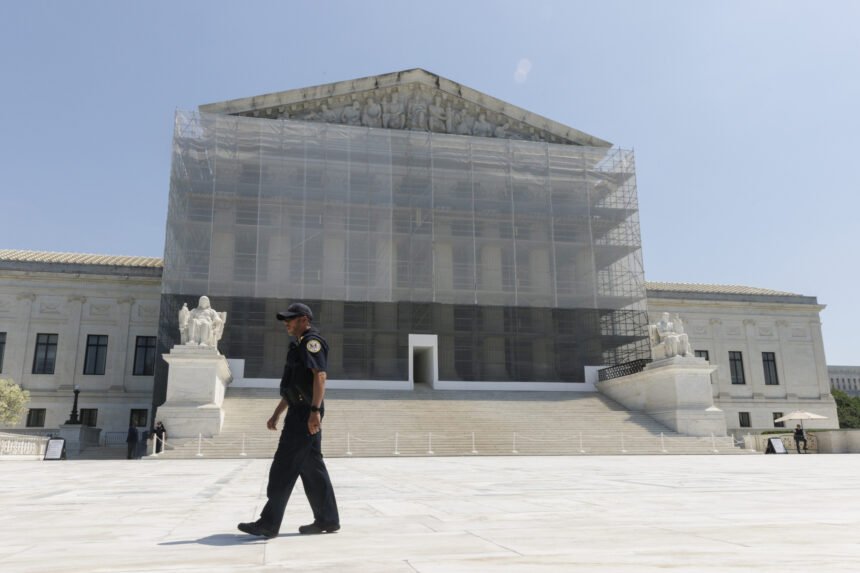The U.S. Supreme Court, which has a 6-3 conservative majority, delivered four unanimous opinions on Thursday, showing a united front on a range of cases.
Why It Matters
The Supreme Court currently holds a 6-3 conservative majority. During President Donald Trump‘s first term, he nominated conservative Justices Neil Gorsuch, Brett Kavanaugh and Amy Coney Barrett.
Voting along ideological lines is viewed aspart of the deterioration of the public’s confidence in the nation’s highest court. Forty-seven percent of Americans expressed a favorable view, and 51 percent held an unfavorable opinion, according to a 2024 Pew Research Center survey. In 1987, 76 percent of Americans viewed the court favorably, while 17 percent had an unfavorable opinion, according to the Pew Research Center.
The same survey found that Democrats are much more likely than Republicans to say that the justices are not doing a good job of keeping their personal politics out of their decisions.
Supreme Court data shows unanimous decisions are not uncommon, with 44 percent of cases decided unanimously in 2023 and 50 percent in 2022. However, in 2021, the percentage dipped down under 30 percent, the lowest in decades.
Photo by Aaron Schwartz/Sipa USA/AP Images
What To Know
On Thursday, the Supreme Court issued six decisions, including four unanimous rulings. In A.J.T. v. Osseo Area Schools, Soto v. United States, Martin v. United States, and Rivers v. Guerrero, all nine justices reached the same conclusion.
Michael Salamone, associate professor of political science in the School of Politics, Philosophy, and Public Affairs at Washington State University, told Newsweek:”The Supreme Court tends to rule unanimously more frequently than a lot of people expect…I find that this is because divided cases get more coverage—not only are the issues that divide the justices often more politically salient, but also the partisan divisions on the Court themselves are newsworthy.”
The have been numerous high-profile, divisive decision, such as the 2022 ruling to overturn Roe v. Wade.
“The justices may also believe they have more credibility when they rule unanimously, and they may therefore strategically compromise to achieve a united front. However, I do not find any evidence that unanimity actually boosts public support for the Court or its ruling,” he added.
In A.J.T., the court ruled: “Schoolchildren bringing ADA and Rehabilitation Act claims related to their education are not required to make a heightened showing of ‘bad faith or gross misjudgment’ but instead are subject to the same standards that apply in other disability discrimination context.” Chief Justice John Roberts authored the opinion.
The ruling came after A.J.T., a student with epilepsy, sued her Minnesota public school over denying her request for evening instruction related to her medical condition, which resulted in fewer instruction hours than her peers.
In another ruling, the court unanimously held that the six-year limitations period under the Barring Act does not apply to claims brought under the Combat-Related Special Compensation statute. The ruling came in the case of Marine Corps veteran Simon Soto, who sought retroactive benefits for service-related PTSD.
The Supreme Court unanimously ruled that a Georgia family can proceed with a lawsuit against the federal government after FBI agents mistakenly raided their home during a botched operation. The justices held that the Federal Tort Claims Act does not shield the government from liability under the Supremacy Clause or discretionary-function exception in such cases.
In a fourth decision, the Supreme Court ruled that a second habeas petition is considered “second or successive” once a district court issues final judgment on the first, even if that judgment is still on appeal. The decision in the case of Texas inmate Danny Rivers means he needed appellate approval before filing a new petition based on newly discovered evidence.
What People Are Saying
Attorney Patrick Jaicomo, who represents the plaintiffs in Martin v. U.S., in a statement: “We look forward to continuing this fight with the Martins in the Eleventh Circuit and making it easier for everyday people to hold the government accountable for its mistaken and intentional violations of individual rights.”
Roman Martinez, a lawyer for Ava Tharpe in A.J.T. v. Osseo Area Schools, told Reuters in a statement: [The ruling is] “a great win for Ava, and for children with disabilities facing discrimination in schools across the country…We are grateful to the Supreme Court for its decision holding that these children should enjoy the same rights and protections as all other Americans with disabilities.”
What Happens Next
The Supreme Court is expected to release a slew of opinions in the coming weeks, with the term scheduled to end in late June.
Update 6/12/25, 5:20 p.m. ET: This article has been updated with comment from Michael Salamone.











